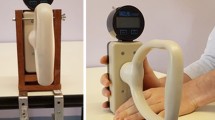Abstract
Purpose
The aim of this study was to determine the ideal forearm position that allows maximum upper-limb function. In certain congenital/acquired upper-limb disorders, the management boils down to sacrificing rotatory movements of the forearm. The position of fusion that facilitates maximum upper-limb function is a topic of debate and is decided upon by personal preferences and assumptions. Although the literature has many level five evidence reports, there is a lack of well-designed research to answer the same question and we intended to study it both in dominant and non-dominant limbs.
Methods
15 healthy adolescent volunteers were fitted with a custom adjustable brace that simulated forearm arthrodesis in five rotatory positions. They were asked to carry out a series of activities as per Sollerman’s hand function test, and each activity was scored using the standardized scoring system. The test was carried out with the brace fitted first in the dominant side, followed by the non-dominant side, and finally in both the upper limbs together.
Results
We found that the mid-prone position allowed for the best function overall in both dominant and non-dominant upper limbs, and if both upper limbs required simultaneous fusion, our results suggest that fixing the dominant side in mid-prone and non-dominant side in 45° supination would be ideal.
Conclusions
For unilateral forearm arthrodesis, the ideal position of fusion is the same irrespective of the dominance of the limb, whereas, for bilateral arthrodesis, limb dominance is to be taken into consideration.
Level of Evidence
Level III quasi-experimental study.




Similar content being viewed by others
Data availability
The data collected from this study, including the master sheet, statistical analysis and study protocol will be made available along with publication of this article as supplementary materials.
References
Castle, M. E. (1974). One-bone forearm. Journal of Bone and Joint Surgery. American Volume, 56, 1223–1227.
Haque, I. U. (1982). The production of a one-bone forearm as a salvage procedure after haematogenous osteomyelitis. A case report. Journal of Bone and Joint Surgery. British Volume, 64, 454–455. https://doi.org/10.1302/0301-620X.64B4.7096420
Lowe, H. (1963). Radio-ulnar fusion for defects in the forearm bones. The Journal of Bone and Joint Surgery British, 45, 351–359.
Jacobson-Sollerman, C., & Sperling, L. (1977). Grip function of the healthy hand in a standardized hand function test. A study of the Rancho Los Amigos test. Scandinavian Journal of Rehabilitation Medicine, 9, 123–129.
Wang, A. A., Jacobson-Petrov, J., Stubin-Amelio, L., & Athanasian, E. A. (2000). Selection of fusion position during forearm arthrodesis. The Journal of hand surgery, 25, 842–848.
Chan, P., Blazer, P., Bozentka, D., Gonzalez, J., Naranja, R., & Roros, B. (1999). Optimal position for the one-bone forearm: An analysis using a hinged brace in normal subjects. The Journal of Hand Surgery: British & European, 24, 724–726.
Green, W. T., & Mital, M. A. (1979). Congenital radio-ulnar synostosis: Surgical treatment. The Journal of bone and joint surgery American, 61, 738–743.
Simmons, B. P., Southmayd, W. W., & Riseborough, E. J. (1983). Congenital radioulnar synostosis. The Journal of hand surgery, 8, 829–838.
Richards, L. G., Olson, B., & Palmiter-Thomas, P. (1996). How forearm position affects grip strength. American journal of occupational therapy, 50, 133–138.
Bohannon, R. W. (2003). Grip strength: A summary of studies comparing dominant and nondominant limb measurements. Perceptual and motor skills, 96, 728–730.
Funding
The authors declare that the expenditure incurred in this project were borne by the authors themselves, and they have not taken help from any external funding source.
Author information
Authors and Affiliations
Corresponding author
Ethics declarations
Conflict of interest
The authors confirm that they have no conflict of interests to declare.
Ethical approval
Ethical approval was obtained from Institute Ethics committee of PGIMER Chandigarh before commencing the study. This study has been performed in accordance with the ethical standards in the 1964 Declaration of Helsinki.
Consent to participate
Informed consent was taken from all participants and from their parents before enrolling in this study.
Consent for publication
The authors and all participants of this study give their full consent for publication of this study in this journal.
Clinical Trials Registry (www.ctri.nic.in) Number
CTRI/2019/06/019869
Additional information
Publisher's Note
Springer Nature remains neutral with regard to jurisdictional claims in published maps and institutional affiliations.
Rights and permissions
Springer Nature or its licensor (e.g. a society or other partner) holds exclusive rights to this article under a publishing agreement with the author(s) or other rightsholder(s); author self-archiving of the accepted manuscript version of this article is solely governed by the terms of such publishing agreement and applicable law.
About this article
Cite this article
Baburaj, V., Gopinathan, N.R., Koundal, N. et al. Optimal Forearm Position Allowing Maximum Hand Function: A Quasi-experimental Study in Adolescent Children. JOIO 57, 923–929 (2023). https://doi.org/10.1007/s43465-023-00855-0
Received:
Accepted:
Published:
Issue Date:
DOI: https://doi.org/10.1007/s43465-023-00855-0




